PROCEEDINGS OF THE CONFERENCE "RAPID TRANSGRESSIONS INTO SEMI-ENCLOSED BASINS"
May 8–10, 2003, Gdańsk–Jastarnia, Poland
Scientific Editors: Szymon UŚCINOWICZ, Panagiotis BALABANIS, Regina KRAMARSKA, Joanna ZACHOWICZ
PREFACE |
|
The International Geological Correlation Programme (IGCP) is a joint endeavour between UNESCO (United Nations Educational, Scientific and Cultural Organisation) and IUGS (International Union of Geological Sciences). It was launched in 1972 to facilitate cooperation between geoscientists across frontiers and boundaries. Its objective is to bring scientists from around the world together and enhance interaction, particularly between North and South, through joint research work, meetings and workshops. This goal is accomplished by establishing 5-years long, subject specific projects. Projects are typically world-scale; at present some 40 projects are active. IGCP project 464 Continental Shelves during the Last Glacial Cycle: Knowledge and Applications was approved and established in 2001 to discuss and compare data on continental shelf evolution during the last climatic/eustatic/depositional cycle. This interdisciplinary project brings together researchers specialising in variety fields of geology, geography, archaeology and climatology. Through investigation, synthesis of ideas and collaboration with colleagues, greater understanding will be achieved of the character and controlling factors influencing global shelf evolution. It is anticipated that advancements will be made in the understanding of global shelf geometry, palaeogeography, palaeomorphology, carbon budgeting, cultural heritage, as well as of stratigraphic sequencing methods, models and training. European Regional Conference, 2003 “Rapid Transgressions Into Semi-Enclosed Basins” was hold in Jastarnia, Poland 8–10 May 2003, organised by the Polish Geological Institute, Branch of Marine Geology and PGI Centre of Excellence: Research on Abiotic Environment “REA”. Abrupt sea level changes in semi-enclosed basins was the main topic of the meeting. Second topic was heritage of human culture: witnesses of environmental changes and shelf narrowing on human pre-history, disappearance of flat coastal areas suitable for cultural/population transmigrations and constant flooding. In the conference participated 43 scientists from Argentina, Australia, Denmark, Estonia, France, Lithuania, Germany, Portugal, Poland, Russia, Sweden and Italy. During two days conference, 20 papers and 14 posters were presented concerning fast sea level changes in the Black Sea, in Gulf of Carpentaria and in the Baltic Sea, also related to palaeogeography, sedimentology, palaeoclimate and geoarchaeology. During the one day excursion, the problems of sea level changes in relation to human activity on the shore of Puck Lagoon were presented and discussed basing on example of Neolithic seal hunters settlement and Medieval harbour remains in Puck. Second part of the excursion was focused on barrier and lagoon development as well as on moving dunes in Słowiński National Park. This volume of the Polish Geological Institute Special Papers presents papers submitted by authors as the extended versions of the presentations which were given during the conference. The volume consists of 13 papers which cover three groups: — scientific papers presenting case studies of wide European regional interest of Black Sea (Fouache et al.), Iberian Atlantic coast (Dias et al.) and Baltic Sea (Uścinowicz, Lampe and Janke, Bitinas and Damušytė, Hoffmann); — scientific review works presenting palaeogeography of the South America — Argentinian coast (Violante and Cavallotto), as well as of the Gulf of Finland — Baltic Sea (Spiridonov and Zhamoida) and archaeological data for reconstruction of coastal changes (Pomian); — scientific reviev and methodological information concerning analysis of radiocarbon dates for reconstruction of environmental changes (Michczyńska et al.), methodological works on investigation of seabed morphology, as well as present day shoreline changes (Wodzinowski, Gajewski et al., Graniczny et al.). SCIENTIFIC EDITORS |
RAPID SEA LEVEL CHANGES IN THE SOUTHERN BALTIC DURING LATE GLACIAL AND EARLY HOLOCENE |
|
Szymon UŚCINOWICZ |
|
Polish Geological Institute, Marine Geology Branch, ul. Kościerska 5, PL-80-328 Gdańsk, Poland; e-mail: Ten adres pocztowy jest chroniony przed spamowaniem. Aby go zobaczyć, konieczne jest włączenie w przeglądarce obsługi JavaScript. p. 9–18 |
|
Abstract. In the area of the southern Baltic Sea, the largest and most violent changes in water level took place in Late Glacial and Early Holocene, during the period between 13.0–8.5 ka BP. These changes depended on the varied glacio-isostatic movements between the northern and southern parts of the Baltic Sea, the glacio-eustatic increase in the ocean level and the closing or opening of the connection between the Baltic Sea basin with the ocean. During the Late Glacial and Early Holocene, the sea level changed within an amplitude as wide as 25–27 m. In some extreme cases, the sea level could have fallen at a rate of about 100–300 mm/a, the sea level rise rate reaching up to about 40–45 mm/a. In Late Glacial and Early Holocene, there were three transgressions: during 12.0–11.2, 11.0–10.3 (the Baltic Ice Lake) and 10.2–9.2 ka BP (the Yoldia Sea and the Ancylus Lake). There were also three regressions, setting on 11.2, 10.3 and 9.2 ka BP. During regressions, depending on the real drainage rate and the local gradient of the bottom inclination, the land possibly grew at a rate of 0.3 to 4 km per year. During transgressions, rate of shoreline migration could reach in some cases up to 150–200 m per year. These processes took place on the surface of the sea bottom currently located at the depth of c. 55 to 25 m below sea level and from 30 to 60 km away from the present-day southern coast of the Baltic Sea. Rapid changes of shoreline position are recorded in progradational barrier structures and in the erosion surfaces of the glacial till and glacio-marine clays.
|
|
THE HOLOCENE SEA LEVEL RISE IN THE SOUTHERN BALTIC AS REFLECTED IN COASTAL PEAT SEQUENCES |
|
Reinhard LAMPE, Wolfgang JANKE |
|
University of Greifswald, Institute of Geography, Friedrich-Ludwig-Jahn-Str. 16, D-17489 Greifswald, Germany p. 19–30 |
|
Abstract. Coastal peatlands depend in respect to their vertical growth totally on the sea level, are witnesses of its variations and, furthermore, preserve remnants of organisms which permit conclusions about the nutrient content and salinity of the flood water and thus of the surrounding sea. Black layers which occur frequently in the peat profiles point to evolution phases whereas the sea level fell or the mire became desiccated. Around thirty radiocarbon data, data from pollen and diatom analyses as well as from geochemical investigations provide the base to reconstruct the sea level history. The placement of particular transgression/regression stages could be determined with a higher accuracy than before and demonstrate a strong correlation to climate oscillations such as to the Late Bronze Age dry period or the Little Ice Age climate deterioration. Uncertainties still remain in regard to the regression magnitudes and to the length of the hiatuses in the peat sequences.
|
|
| CHANGES TO THE COASTLINE IN THE NEIGHBOURHOOD OF THE MEDIEVAL HARBOUR IN PUCK IN THE LIGHT OF THE RESEARCH DONE BY THE POLISH MARITIME MUSEUM IN GDAŃSK | |
Iwona POMIAN |
|
Department of Underwater Archaeology, Polish Maritime Museum, Ołowianka 9/13, 80-751 Gdańsk, Poland; e-mail: Ten adres pocztowy jest chroniony przed spamowaniem. Aby go zobaczyć, konieczne jest włączenie w przeglądarce obsługi JavaScript. p. 31–36 |
|
Abstract. The site was discovered in 1977 by amateur scuba divers. During preliminary excavation in the Puck Lagoon, a massive system of timber structures, fascine, and stone as well as earthen embankments scattered over an area of over 12 hectares, were found. Looking at the chronological arrangement of the site, slowly reconstructed on the basis of dendrochronological analyses and supplemented with radiological research, it should be assumed that the northern strip of the construction is a continuation of the quay strengthening construction, the root of a harbour pier. It is probably the earliest stage of the Puck harbour development. Taking both the layout of the construction, working as defences of the swampy alluvial estuary of the Płutnica river, parallel to the present coastline, as well as chronological layout of the stand, which gets younger and younger the closer it gets to the present shore line, it may be assumed that the changes in the location of the port construction were influenced by quite quick deepening of the basin and movement to the south of the medieval shore line.
|
|
THE LITTORINA SEA AT THE LITHUANIAN MARITIME REGION |
|
Albertas BITINAS1, Aldona DAMUŠYTĖ1 |
|
1 Geological Survey of Lithuania, 35 S. Konarskio St., LT-2600 Vilnius, Lithuania; e-mails: Ten adres pocztowy jest chroniony przed spamowaniem. Aby go zobaczyć, konieczne jest włączenie w przeglądarce obsługi JavaScript., Ten adres pocztowy jest chroniony przed spamowaniem. Aby go zobaczyć, konieczne jest włączenie w przeglądarce obsługi JavaScript. p. 37–46 |
|
Abstract. In the recent decade a number of data of different investigations (pollen, diatom, molluscs analysis, lithological investigations, dating by methods of absolute geochronology, etc.) have been collected during the large-scale geological mapping of Lithuanian Maritime region (Lithuanian Coast). The results of investigations confirmed that there were three Littorina Sea transgressions at the Lithuanian Coast: the first manifested approximately in 8,500–7,800 conventional 14C years BP, the second (maximal) — in 6,200–5,900 and the third — in 5,300–4,000 conv. 14C years BP. The Post-Littorina Sea maximum was in about 3,600–3,400 conv. 14C years BP. The Littorina Sea shoreline displacement curves were carried out. The present-day positions of shorelines of the Littorina Sea as well as other Baltic basins are displaced in different altitudes in separate parts of the Lithuanian Coast due to oscillatory neotectonic movements of Earth crust blocks during Late Glacial and Holocene.
|
|
THE ROLE OF NEO-TECTONICS IN THE VARIATION OF THE RELATIVE MEAN SEA LEVEL THROUGHOUT THE LAST 6000 YEARS ON THE TAMAN PENINSULA (BLACK SEA, AZOV SEA, RUSSIA) |
|
Eric FOUACHE1, Alexei POROTOV2, Christel MÜLLER3, Youri GORLOV4 |
|
1Université de Paris XII, IUF, EA 435, 61 avenue du Général de Gaulle, 94010 Créteil, France; e-mail: Ten adres pocztowy jest chroniony przed spamowaniem. Aby go zobaczyć, konieczne jest włączenie w przeglądarce obsługi JavaScript. 2Geography Faculty, Moscow State University 3 Université de Paris I, École Française d'Athènes 4 Institute of Archaeology, Russian Academy of Sciences str. 47–58 |
|
Abstract. Sediments, carbon-datings on seashells, allow us to reconstruct the evolution of the average sea level for some 6,000 years on the Taman Peninsula. The current sea level, regionally, appears to be the highest level ever reached on the peninsula. It seems that for the Anapa area and Tchouchtchka Spit area it is possible to propose a sea level curve characterised by a slow, continuous rising during the past 6,000 years. On the Taman Peninsula itself, the sedimentary record of this slow ascent has been distorted by a heavy tectonic subsidence. We have identified this neo-tectonic subsidence effect on at least two areas on the peninsula. The south of the peninsula, Burgaz Spit and Vityazevos Lagoon, is the most affected area. The Taman Gulf is an intermediate area. The tectonic subsidence is particularly noticeable from 1,500 to 500 BC, which we believe to have been misinterpreted until now, and to be at the origin of the notion of “Phanagorian Regression”.
|
|
EVOLUTION OF THE SEMI-ENCLOSED BASINS AND SURROUNDING COASTAL PLAINS ADJACENT TO THE PAMPEAN REGION, ARGENTINA |
|
Roberto A. VIOLANTE1, José L. CAVALLOTTO1 |
|
1 Argentina Hydrographic Office, Department of Oceanography, Division of Marine Geology and Geophysics; Av. Montes de Oca 2124, C1270ABV Buenos Aires, Argentina p. 59–70 |
|
Abstract. The coastal plains adjacent to the Pampean region in eastern Argentina evolved during the Holocene in response to interaction between sea level fluctuations and different littoral dynamic factors in such a way that several sedimentary environments developed. Evolutionary stages can be synthesised in three periods: 1) the post-LGM transgression, when landward migrating coastal barriers extended on the present shelf under the effect of a dominant northward littoral drift; 2) the last stages of the transgression (between 8,000 and 6,000 years BP), when the rising sea flooded the Alto Marítimo (a pre-Holocene positive morphological feature which in previous times separated the course of the de la Plata river from the open sea), resulting in a new coastal configuration in which the presence of two headlands, Punta Piedras (in the north) and Villa Gesell (in the south), influenced the coastal processes so changing the original regional northward littoral drift into cell-type circulation systems; 3) between 6,000 years BP and the present, when progradation processes characterised by barriers and beach ridges development dominated as a result of the sea level fall and an excess of sediment supply. As a result, coastal semi-enclosed basins located in between the headlands, such as Samborombón bay and Mar Chiquita lagoon, became the main depocenters where low-energy conditions (coastal lagoons, tidal flats and marshes) prevailed due to its isolation from the open-sea by the barriers and ridges. Interaction between southward migration of coastal environments associated to the northern headland and northward migration of those related to the southern headland was a very important process in shaping the present morphology of the area.
|
|
THE NATURAL AND ANTHROPOGENIC FEATURES OF THE COASTAL ZONE OF THE EASTERN GULF OF FINLAND |
|
Mikhail A. SPIRIDONOV1, Vladimir A. ZHAMOIDA1 |
|
1 All-Russia Geological Institute (VSEGEI), Sredny Prospect 74, 199106, St. Petersburg, Russia; e-mail: Ten adres pocztowy jest chroniony przed spamowaniem. Aby go zobaczyć, konieczne jest włączenie w przeglądarce obsługi JavaScript. p. 71–76 |
|
Abstract. The development of the coastal zone of the eastern Gulf of Finland has a long geological history and depends on the several main factors. The primary configuration of the shoreline is connected with tectonic movements, which even at present are displayed in slow uplifting of the northern coast and slow sinking of the southern one. However, the main features of the recent coastal zone were formed during degradation of the last glacial cover and essentially transformed during post-glacial period of different water bodies’ existence. The processes of the modern morpho- and litho-dynamic are very changeable and expressed in the different accumulative and erosion forms of relief. The anthropogenic activity during last centuries results in local reconstruction of the conditions of existence and development of the coastal zone.
|
|
THE ROLE OF THE DAY BY DAY BEACH MONITORING IN SHORE TRANSFORMATION |
|
Tycjan WODZINOWSKI |
|
University of Gdańsk, Institute of Oceanography, Department of Marine Geology, Al. Marsz. Piłsudskiego 46, 81-378, Gdynia, Poland; e-mail: Ten adres pocztowy jest chroniony przed spamowaniem. Aby go zobaczyć, konieczne jest włączenie w przeglądarce obsługi JavaScript. p. 77–82 |
|
Abstract. The new method of a detailed morphodynamic registration of sandy beaches has been presented. The digital oriented photograms have been taken from a stabilised point at least once a day. Occasionally also more often, for example every hour during a storm cycle. The analyses of the photograms are performed in digital mode using special computer software. This digital beach monitoring of the Polish Baltic coast was initiated in summer 2002. The test fields in Polanka Redłowska within Gdynia and Chłapowo near Władysławowo were selected. The beach areas of the length of about 200 m along the shore were registered there. Selected examples of short-term changes of the beach relief were presented. A range of spatiotemporal transformations related to different periods (hours, days, months etc.) was demonstrated.
|
|
POSTGLACIAL TO HOLOCENE SEDIMENTATION HISTORY AND PALAEOGEOGRAPHICAL DEVELOPMENT OF A BARRIER SPIT (PUDAGLA LOWLAND, USEDOM ISLAND, SW BALTIC COAST) |
|
Gösta HOFFMANN |
|
Universität Greifswald, Institut für Geologische Wissenschaften Jahnstr. 17a, 17487 Greifswald, Germany; e-mail: Ten adres pocztowy jest chroniony przed spamowaniem. Aby go zobaczyć, konieczne jest włączenie w przeglądarce obsługi JavaScript. p. 83–90 |
|
Abstract. Pudagla lowland is a Holocene barrier spit on the SW Baltic coast. Framed and underlain by Pleistocene deposits, the depression is filled up with up to 20 m of Late Glacial to Holocene sediments. 63 cores were collected using a vibrocore technique. Samples were analysed in terms of granulometry, species associations (molluscs, ostracods). Organic sediments (peat) were used for radiocarbon dating. In total 6 new 14C-data are presented. The sediment sequence starts with a Late Glacial till, overlain by glaciofluvial sand. A lake developed during the Late Preboreal/Early Boreal with a water level of –8 m mean sea level (m.s.l.) with sand the predominant sediment. Minor lakes existed during the Boreal. At around 6,500 BP the Littorina transgression reached the study area. Mud and fine to medium sand were deposited forming a barrier spit. At around 1,000 BP, the entire Pudagla lowland became terrestrial with peat as the most common surface sediment. Palaeogeographical development is demonstrated by nine evolutionary stages. The assumption of Kliewe, Janke (1982) that the transgression onset varies regionally at the coast of the southern Baltic Sea can be proven by comparison with other areas which have been subject to prior investigations.
|
|
THE RELIEF OF THE OFFSHORE SEA BOTTOM AT KARWIA–CHAŁUPY, POLISH BATIC COAST |
|
Leonard GAJEWSKI1, Łukasz GAJEWSKI1, Stanisław RUDOWSKI1,2, Aleksandra STACHOWIAK1 |
|
1 Operational Oceanography Department, Maritime Institute in Gdańsk, Długi Targ 41/42, 80-830 Gdańsk, Poland; e-mail: Ten adres pocztowy jest chroniony przed spamowaniem. Aby go zobaczyć, konieczne jest włączenie w przeglądarce obsługi JavaScript. 2 Marine Geology Department, Institute of Oceanography, University of Gdańsk, Al. Marszałka Piłsudskiego 46, 81-378, Gdynia, e-mail: Ten adres pocztowy jest chroniony przed spamowaniem. Aby go zobaczyć, konieczne jest włączenie w przeglądarce obsługi JavaScript. p. 91–94 |
|
Abstract. Morphology of sea bottom of the Władysławowo area, from Karwia to Chałupy, has been studied based on the detailed digital bathymetric map prepared in a scale of 1:25 000 with isobaths every 0.25 m. A significant differentiation of the bottom relief has been observed, with the level changes up to 1–3 metres, mostly connected with the occurrence of specific systems of ridges and runnels. They are probably partly relict forms (fluvial and/or coastal?), changed to certain degree during the rapid stage of the Litorina transgression, and in partly forms created by the recent waves. Several types of the sea bottom surface, differing in pattern of morphological forms, have been recognised within inshore, near shore, and open sea (above 16 m depths) areas. The full knowledge of the origin and development of these relief forms requires further specialised research, currently carried out. Nonetheless, the already obtained picture of the sea bottom relief indicates an intensified abrasion of the offshore sea bottom, and an intensive, irreversible sweeping out of the sediments from the shore to the open sea, most probably by rip currents, at a distance up to several kilometres from the shore. It is in accordance with the results of a former large-scale (1:500) study of the sea bottom at the test field at Chłapowo, performed with the use of an integrated system of non-invasive and direct methods.
|
|
NATURAL VERSUS ANTHROPIC CAUSES IN VARIATIONS OF SAND EXPORT FROM RIVER BASINS: AN EXAMPLE FROM THE GUADIANA RIVER MOUTH (SOUTHWESTERN IBERIA) |
|
| João M. Alveirinho DIAS1, Ramon GONZALEZ2, Óscar FERREIRA1 | |
| 1 FCMA/CIMA, Universidade do Algarve, Campus de Gambelas, 8000-117 Faro, Portugal 2 CIACOMAR/CIMA, Universidade do Algarve, Avenida 16 de Junho s/n, 8700-311 Olhão, Portugal p. 95–102 |
|
Abstract. Flood events in many river basins with highly variable discharge values remove accumulated sediments from the riverbed and estuaries. These sediments are exported to the shelf and the adjacent coastlines. Data for rainfall and river discharge for the Guadiana River basin in southwestern Iberia show a strong link with North Atlantic Oscillation (NAO) index patterns. A negative NAO index usually results in more rainfall, and subsequent flooding in the river basin during winter months. During the second half of the 20th century, the flow regime of the Guadiana River and its tributaries have been increasingly constrained by the construction of dams. The consequences were a reduction of coarse-grained sediment export from the upper river basin to the estuary, and a reduction in the number and type of floods.
|
|
RECENT DEVELOPMENT OF THE VISTULA RIVER OUTLET |
|
Marek GRANICZNY1, Tomasz JANICKI1, Zbigniew KOWALSKI1, Dorota KOSZKA-MAROŃ2, Wojciech JEGLIŃSKI2, Szymon UŚCINOWICZ2, Joanna ZACHOWICZ2 |
|
1Polish Geological Institute, Rakowiecka 4, 00-975 Warszawa, Poland 2Polish Geological Institute, Branch of Marine Geology, Kościerska 5, 80-328 Gdańsk, Poland p. 103–108 |
|
Abstract. The Vistula River mouth is an unique example of river’s outlet observed since the birth in 1895 to present day. There is a large documentation of morphological changes in the outlet area. In 1895, a 7 kilometres canal was dug into which the waters of the Vistula were let in. Since 1895, most of the water discharge and all sediment transport reach the Gulf through artificial channel c. 20 km east of Gdańsk. During the last 100 years, the shoreline has been shifted seaward c. 1.5 km on the eastern side, to c 2.5 km on the western side of the Vistula mouth. Isobath of 5 m moved seaward c. 3 km and isobaths of 10 and 15 m shifted 2.5 km. During the years 1895–1997, land area accreted to 3,019,000 m2. The volume of the river-outlet cone in the year 2000 was 133.39 mln m3 and the average rate of sediment growth over the 105 years was c. 1.27 mln m3 per year.
|
|
| STATISTICAL ANALYSIS OF RADIOCARBON DATES AS TOOL FOR RECONSTRUCTION OF ENVIRONMENTAL CHANGES | |
Danuta J. MICHCZYŃSKA1, Adam MICHCZYŃSKI1, Anna PAZDUR1, Karol ROTNICKI2 |
|
1 GADAM Centre, Institute of Physics, Silesian University of Technology, Krzywoustego 2, 44-100 Gliwice, Poland 2 Institute of Quaternary Research and Geoecology, Adam Mickiewicz University, Fredry 10, 60-701 Poznań, Poland p. 109–112 |
|
Abstract. Statistical analysis of large sets of 14C dates may be a source of information on global or regional environmental changes. Since the nineteen seventies, an analysis of the frequency distribution on a time scale of 14C-dated samples has been carried out for several selected geographic regions. This paper presents basics of the applied method and examples of cumulative probability density functions constructed for 14C dates of peat from territory of Poland. It is emphasised that preferential sampling plays an important role in such a type of analysis. The problem of absolute age determination has been discussed, too.
|
|
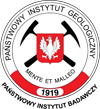





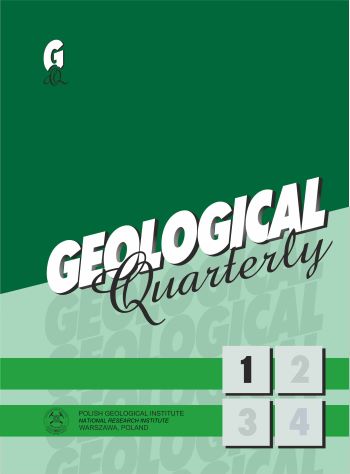 Geological Quarterly Vol 67, No 4 (2023)
Geological Quarterly Vol 67, No 4 (2023)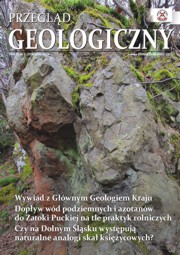 Przegląd Geologiczny
Przegląd Geologiczny Volumina Jurassica Vol 21 (2023)
Volumina Jurassica Vol 21 (2023)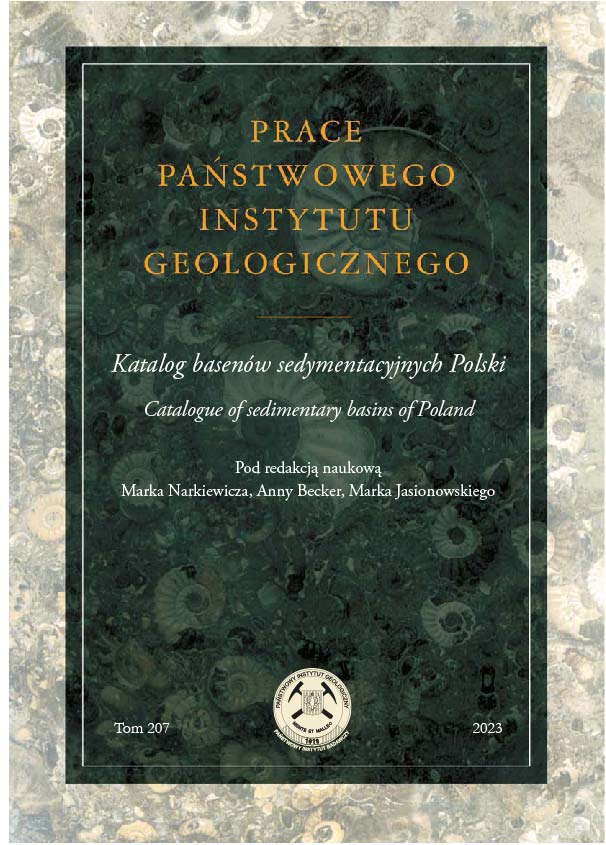 Prace PIG Tom 208 (2023)
Prace PIG Tom 208 (2023)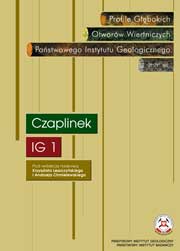 Profile Głębokich Otworów Wiertniczych (2023)
Profile Głębokich Otworów Wiertniczych (2023)